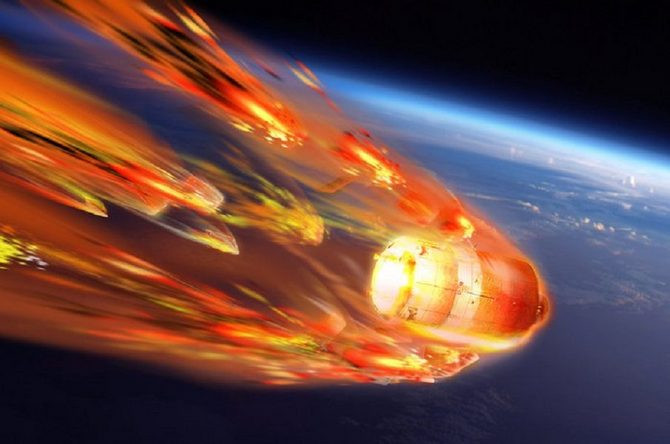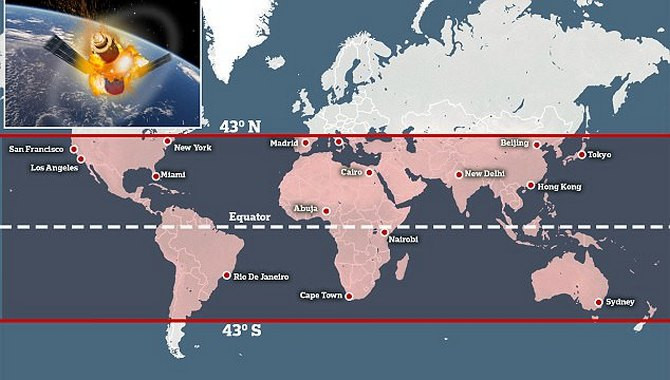Out of control, the 8.5-ton Thien Cung 1 space station was about to fall to Earth
has lost control over the past few months and is expected to fall to Earth in early 2018
Although it is forecasted early, at present, scientists still cannot accurately predict the fall position of Thien Cung 1 space station.

This used to be a place for astronauts to carry out short-term missions.
According to BGR, the Thien Cung 1 space station was launched in 2011 and is China's first space station. This used to be a place for astronauts to carry out short-term missions.
But after the mission ended in 2016, the Chinese Space Agency confirmed it had lost contact with the station. According to the current trajectory, it is likely that the station will soon fall to Earth in the near future.
weighs about 8.5 tons and it is estimated that about 10-40% of the debris (0.9 - 3.6 tons) from the hull collides with the Earth's surface, the rest will be destroyed when it falls into atmosphere. If Thien Cung 1 is just a small satellite, things may not be as worrisome as they are today.
Although scientists are watching quite closely to make a forecast about where the collision is accurate. However, at the present time, the experts only partition the effect from the latitude 43 degrees north to 43 degrees south.
Although most of the affected area has an ocean covered around, there is still a chance of colliding with the Earth's surface to be around 1 / 10,000. If this chance is unfortunate, debris can cause damage to people and cities around the world.

The lands located in the 43th parallel North and 43 degrees South are at risk of being visited by fragments of Thien Cung 1 station.
Besides the dangers of the fragment of the space station, another risk that scientists are also worried about is hydrazine (N 2 H 4 ) , a toxic chemical that smells like ammonia, often Used as a rocket fuel and not disintegrated if dropped to the ground surface.
If this substance comes into contact with a human or animal body, it can cause poisoning, injury, death and danger rather than a serious ecological disaster.
Thien Cung 1 space station is expected to fall to Earth in the period from now until March 2018.
Although observers can predict at least 2 weeks before the space station falls. But once it has entered the Earth's atmosphere, scientists will have very little time to make predictions, warnings of impact areas or affected areas.
The danger is that, but it should not be too worrying because the probability of inflicting human suffering is not high.
Satellite or spacecraft falls to Earth regularly. With low orbit aircraft, the atmosphere can be completely burned before landing. But it is with small ships or satellites while Thien Cung 1 is a completely different matter.

The probability of Thien Cung 1 space station causing harm to people is not high.
In 2011, Russia launched a Phobos-Grunt spacecraft on Mars but failed. Finally, the ship weighs 13.6 tons trapped in Earth's low orbit. Later, Phobos-Grunt fell into the Pacific Ocean in 2012 without causing any effect on humans.
The good news is that in the past more than 50 years, few people have been injured by spacecraft fragments. According to The Verge, only the case of an American woman named Lottie Williams was struck by a 15cm piece of Delta II booster rocket while walking.
In addition, the event of Heavenly Bow 1 hitting Earth will become an important test for future spacecraft or meteorite debris forecasting models.
- The Chinese space station will fall to Earth in the next 24 hours
- The second Chinese space station may be about to fall to Earth
- Places of China's 8.5-ton space station could fall
- Thien Cung 2 space station re-enters the atmosphere, being 'controlledly destroyed'
- China's space station is about to plunge to Earth
- China's Thien Cung 1 Station is about to fall freely
- How to observe the 8.5-ton space station is falling indefinitely to Earth
- China's 8.5-ton space station is about to plunge to Earth
- The Chinese space station can fall freely to Earth
- The god ship 10 connected Thien Cung-1
- Photograph of the 8.5 ton Chinese space station about to fall to Earth
- The reason why China's 8.5-ton space station doesn't burn out when it falls
 Van Allen's belt and evidence that the Apollo 11 mission to the Moon was myth
Van Allen's belt and evidence that the Apollo 11 mission to the Moon was myth The levels of civilization in the universe (Kardashev scale)
The levels of civilization in the universe (Kardashev scale) Today Mars, the sun and the Earth are aligned
Today Mars, the sun and the Earth are aligned The Amazon owner announced a secret plan to build a space base for thousands of people
The Amazon owner announced a secret plan to build a space base for thousands of people